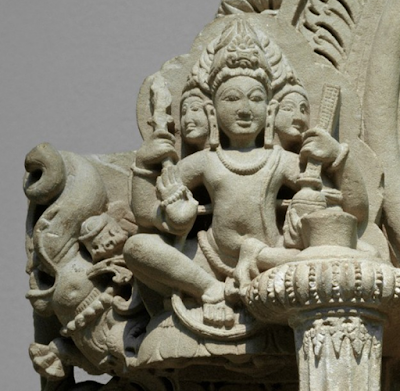Brahma, The Creator
For the past several years, I have been attending the annual yoga therapy conference, SYTAR, and did so again this past June. I always come away with both an expanding perspective on how yoga is being used to improve people’s health and well-being around the world and some new practices that I can use in my personal practice and share with my students. This year, while I was participating in a panel discussion on multidisciplinary approaches to chronic pain, I learned about a new mudra, Brahma mudra (the Divine Spiritual Gesture), from one of my fellow panelists, Dr. Ananda Bhavanani, MD, from Pondicherry, India, who is both a Western trained physician and yoga therapist. Unlike the hand mudra or gestures that I use often in my meditation practice, the Brahma mudra involves movement and sound (NOTE: There is also a hand gesture by the same name, but that is not the subject of this post). And Dr. Bhavanani said this mudra can help you on a physical level for pain and stiffness in the head, neck, shoulders, and upper back and for optimizing the overall functions of the neck region. (The neck is a vital area for your overall health. It is the conduit between your head and body through which your spinal cord and several large blood vessels as well as your large breathing tube and esophagus—your feeding tube—pass. And it is also home to your thyroid gland, which helps to regulate your metabolism.) Dr. Bhavanani also stated this mudra helps cultivate psychosomatic harmony (body-mind balance), can be useful for managing stress and mood swings, cultivating relaxation, instilling a sense of mental lightness, and can enhance and balance our perspectives on life. (That’s a lot of uses and potential benefits! It is important to keep in mind, however that these are claims come from the yoga tradition and results have been reported anecdotally. As far as I know, the effects of this mudra have not been studied systematically or scientifically.) So how, you may be asking, do you do Brahma mudra? Just as the Hindu deity Brahma, the creator, has four heads that point in the cardinal directions of a compass, in this dynamic practice you move your one head in four directions with your breath, using the Bija seed sounds “ah”, “uuu”, “eee” and “mmm”on your four exhalations. (You can watch a video of the practice here and watch Dr. Bhavanani’s entire talk here.) I was immediately interested in Brahma Mudra’s potential benefits for my own neck, having been involved in a car accident years ago that has left me with some chronic stiffness and changes in my range of motion, compounded by my life-long violin playing, which tips and turns my head to the left. Since the conference in mid-June, I have been doing the practice for 9-12 rounds almost every morning. So far, it has been very effective in reducing my stiffness and seems to be slowly improving the range of motion of my neck. And due to the mental focus on movement and on making the Bija sounds, it has both a meditative and pranayama effect of calming, quieting, and centering my mind. Excited by the accessibility and benefits of the practice, I have been teaching the practice to my students and yoga therapy clients in the recent weeks. It is worth mentioning, however, that, as with many yoga practices, there is more than one way to do this mudra. In fact, my colleague Dilip Sarkar, MD has a slightly different version in his new book, Yoga Therapy, Ayurveda, and Western Medicine (pages 103-106). Dilip told me that doing this practice daily for some years now has helped him overcome the symptoms of his cervical radiculopathy, a technical term for neck pain due to degenerative changes in the bone and soft tissue structures of the spine. The following instructions are based on the technique I learned from Dr. Bhavanani. Instructions for Practicing Brahma Mudra1. Take a comfortable seat, either on the floor or on a chair. Sit with good posture and your face forward, and close your eyes. 2. Inhale slowly (over 4-6 seconds) as you slowly turn your head to the right. 3. Exhale slowly (over 4-6 seconds) and make the sound “ah” as you slowly turn your head to center. 4. On your next slow inhalation, slowly turn your head to left. 5. On your slow exhalation, make the sound “uuu” as you slowly turn your head to center. 6. On your next slow inhalation, slowly tip your head back (keep the back of your neck long). 7. On your slow exhalation, make the sound “eee” as you slowly tip your head back to center. 8. On your next slow inhalation, slowly tip your head down, bringing your chin towards chest. 9. On your slow exhalation, make the sound “mmm” as you slowly bring head to center. Repeat the Brahma mudra for 3-12 rounds. Subscribe to Yoga for Healthy Aging by Email ° Follow Yoga for Healthy Aging on Facebook and Twitter ° To order Yoga for Healthy Aging: A Guide to Lifelong Well-Being, go to Amazon, Shambhala, Indie Boundor your local bookstore.Follow Baxter Bell, MD on YouTube, Facebook, and Instagram. For upcoming workshops and retreats see Baxter's Workshops and for info on Baxter see baxterbell.com.


